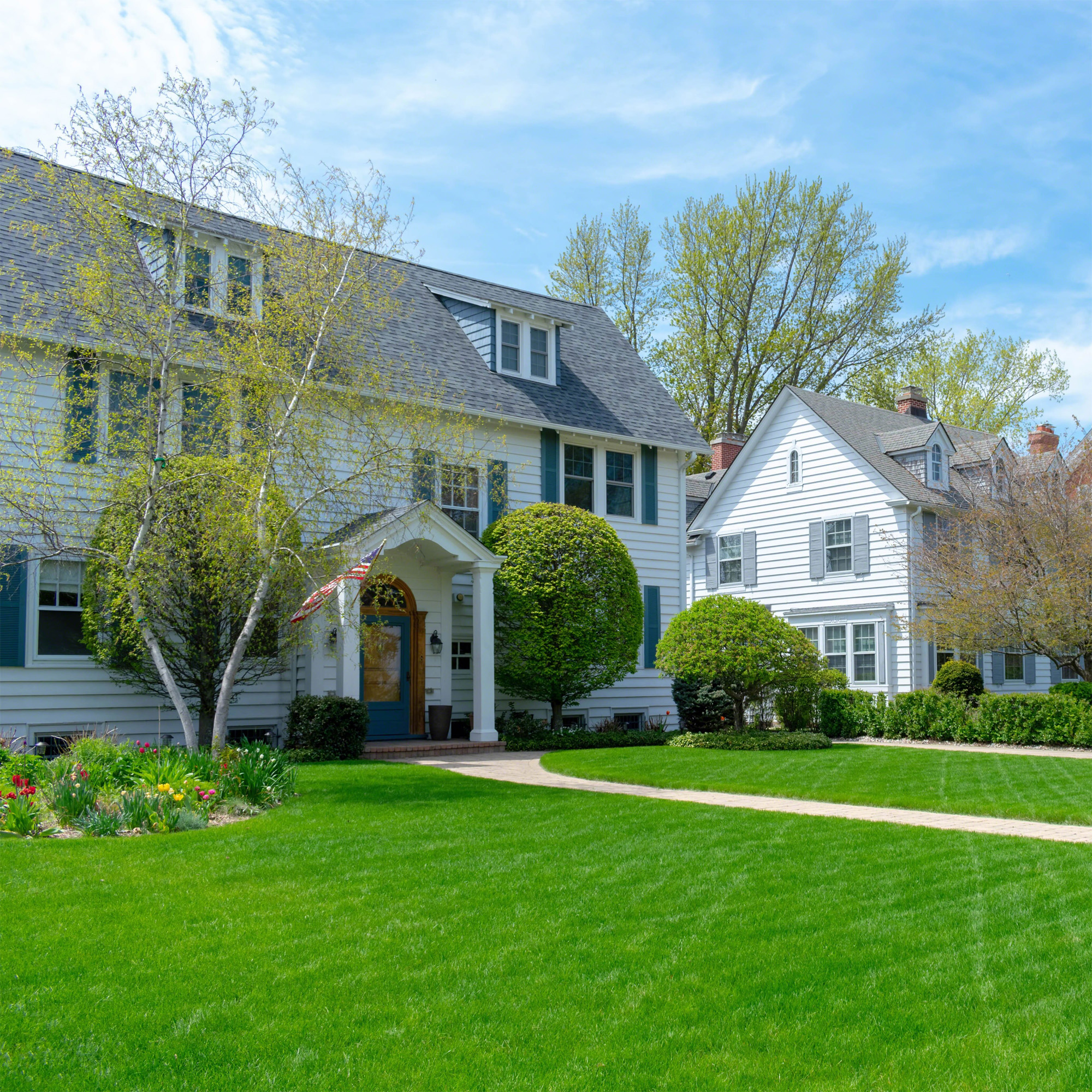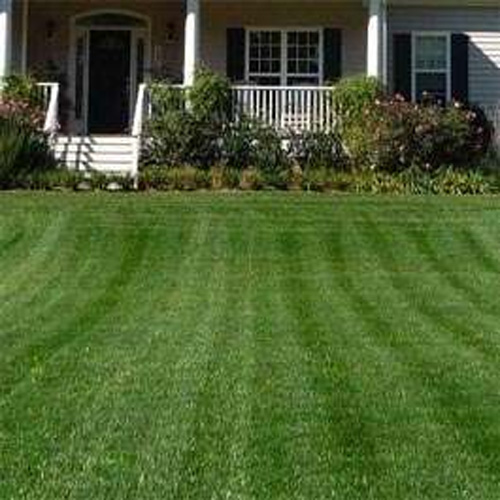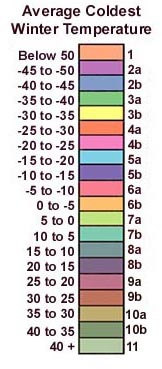
OSP Ryegrass
- Wear Tolerance
- Cold Tolerance
- Lawns

Grasses used in Delaware are divided into two categories based on their climate adaptation. Cool-season grasses grow best in the spring and fall, with optimum growth when the temperature is between 60 and 75 degrees Fahrenheit. Warm-season grasses grow best in the summer, with optimum growth at 80-90 degrees Fahrenheit. Delaware is in the transition zone. Our winters are too cold for warm- season grasses and our summers are too hot for cool- season grasses. Since we are in the northern part of the transition zone, we struggle with the following list of cool-season grasses.
Cool-Season Grasses:
Kentucky Bluegrass - This high-quality turf has a nice green color and good recuperative ability. But, it damages easily, suffers from heat and drought, requires moderately high maintenance, has a tendency to thatch, is susceptible to many diseases, and is intolerant of shade or salt.
Perennial ryegrasses are bunching cool season grasses that are compatible in appearance with bluegrass, do not form thatch, have good heat tolerance and may be drought resistant. They tend to be disease prone and offer poor freezing tolerance if flooded or exposed to wind. Perennial ryegrasses is designed for full sun areas, but will tolerate some shade. Ryegrass is bred to give a pleasing dark green color, with a fine texture and excellent mowing qualities. Is also a very good choice for blends with Kentucky Bluegrass and Fine Fescue.
Tall Fescue - The new turf-type tall fescues are excellent for Delaware. While they take a little while to establish or recuperate since they are a clump-type grass, they are extremely wear resistant; drought-, heat- and salt-tolerant; and moderately shade tolerant. Tall fescues have few disease problems and require less maintenance that other grasses. Kentucky bluegrass is the first grass to brown out in the summer and tall fescue is the last.
Fine-leaf Fescues - Fine fescues have an extremely narrow, almost needle-like leaf blade. They are included in turfgrass mixtures for their excellent shade tolerance. Fine-leaf fescue often appears in neglected lawns because it withstands a high pH. Due to its fine texture, fine-leaf fescue is often difficult to mow.
Bentgrass - This fine-textured grass is unique among cool-season grasses in its ability to be cut at heights of 1/2 inch or less. It has a high disease potential, poor drought tolerance and requires extremely high levels of maintenance. Bentgrass is a weed in home lawns and should be left on the golf course where it belongs.
| Click Name To View Grass Seed Choice | Type | Applications | |
|---|---|---|---|
| Cool Season Mix - Showtime |
|
Cool Season |
Lawns - Full Sun to Moderate Shade Rye, Kentucky Bluegrass, Fine Fescue Mix |
| Cool Season Mix - Garland |
|
Cool Season |
Lawns - Full Sun to Moderate Shade Rye, Fine Fescue Mix |
| Fescue/Bluegrass Mix - Combat Extreme North |
|
Cool Season | Lawns - Wear Tolerant |
| Fescue Blend - Combat Extreme Transition |
|
Cool Season | Lawns - Wear Tolerant |
| Fine Fescue Blend - Legacy |
|
Cool Season | Lawns - Full Sun To Moderate Shade |
| Kentucky Bluegrass - Bluegrass Supreme |
|
Cool Season | Lawns - Golf Gourses - Full Sun |
| Kentucky Bluegrass - Midnight |
|
Cool Season | Lawns - Golf Courses - Full Sun |
| OSP Ryegrass |
|
Cool Season | Lawns - Golf Courses |
| Shade Grass - Poa Supina Mix |
|
Cool Season | Lawns - Full Sun - Deep Shade - Best Shade Grass |


Below is the USDA Zone Map for Delaware so you can determine which zone you reside in. Below that are our picks for your state which will do best in your area. Next on this page are tables which list various grasses and their characteristics so you can compare before you decide on your purchase. Click on the product name (ie. Midnight) for more information about that grass and to make your purchase.
| USDA Zone Map For Delaware | |
|---|---|
 |
 |
| Compare Various Grasses For Their Characteristics | ||||||||
|---|---|---|---|---|---|---|---|---|
| Cool Season Grasses |
Leaf Texture |
Establish Rate |
Nitrogen Use |
Water Use |
Drought Tolerance |
Salinity Tolerance |
Shade Tolerance |
|
| Bentgrass - Creeping | Fine | Moderate to Fast |
Low to Moderate |
High | Poor to Moderate |
High | Poor to Moderate |
|
| Bentgrass - Colonial | Fine | Moderate to Fast |
Low | Moderate | Poor to Moderate |
Moderate | Moderate | |
| Bluegrass - Kentucky | Moderate to Fine |
Slow | Moderate to High |
Moderate to High |
Good | Moderate | Poor | |
| Bluegrass - Rough | Moderate to Fine |
Slow | Moderate to High |
Moderate to High |
Poor | Moderate | Excellent | |
| Fescue - Hard | Fine | Slow to Moderate |
Low to Very Low |
Moderate | Excellent | Low to Moderate |
Excellent | |
| Fescue - Creeping | Fine | Moderate | Low to Moderate |
Moderate | Good | Low | Excellent | |
| Fescue - Turf Type | Moderate to Coarse |
Moderate | Moderate to High |
Low to Moderate |
Excellent | Low | Good to Excellent |
|
| Ryegrass - Perennial | Fine to Moderate |
Very Fast | Moderate to High |
Moderate to High |
Good | Poor to Moderate |
Poor to Moderate |
|
| Compare Various Grasses For Their Characteristics - Continued | ||||||||
|---|---|---|---|---|---|---|---|---|
| Cool Season Grasses |
Fertility Needs |
Wear Resistance |
Mowing Height |
Cold Tolerance |
Acid Soil Tolerance |
Thatching Tendency |
Heat Tolerance |
|
| Bentgrass - Creeping | High | Low | Low | Low | Medium to High |
High | High | |
| Bentgrass - Colonial | High | Low | Low | Low | Medium to High |
High | High | |
| Bluegrass - Kentucky | Medium | Medium to High |
Medium | High | Medium | Medium | Medium | |
| Bluegrass - Rough | Medium | Medium | Medium | High | Medium | Medium | Medium | |
| Fescue - Hard | Low | Low | Medium | Medium to High |
Medium to High |
Low to Medium |
Low to Medium |
|
| Fescue - Creeping | Low | Low | Medium | High | Medium to High |
Low to Medium |
Low to Medium |
|
| Ryegrass - Perennial | Medium | High | Low to Medium |
Medium | Medium | Low | Medium to High |
|